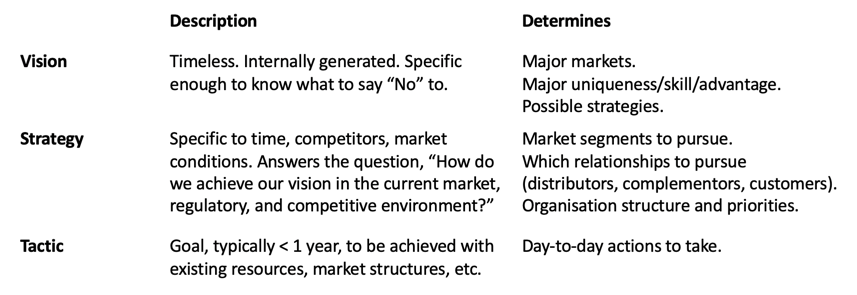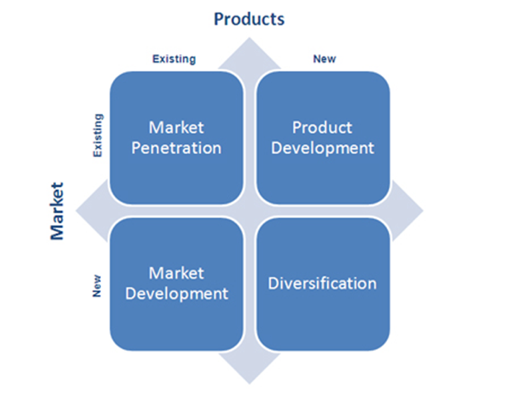Successful leaders understand that if their organisation is to grow in the long term, they can't stick with a "business as usual" mindset, even when things are going well. They need to find new ways to increase profits and reach new customers.
There are numerous options available, such as developing new products or opening up new markets, but how do you know which one will work best for your organisation?
Vision and Mission Statement
The difference between Why and How also introduces the difference between the Vision & Mission statements of an organisation, and the Strategy needed to implement it.
The Vision is the founder’s intent, Why the company was founded. The Mission is a general statement of how you will achieve the vision description.
For example:
Vision: ‘To be the most admired global brand in currency solutions’
(an audacious claim)
Mission: ‘To roll out differentiated technology and innovative products year on year’
(actions to execute on)
Your vision lays out a destination; your destination guides your strategy; and strategy directs action.
It’s action that leads to success.
First – lay out a destination…
Vision is timeless. It’s based on what you want to do. It’s why you’ve got an organisation in the first place. It must be specific enough so that everyone can use it to decide if their work is moving the company forward. Progress towards the vision must be measurable. A vision is independent of specific competition, and while it may mention the customer, it must guide even someone who doesn’t know the customers’ mind. The best visions imply whom the company serves, what it provides, and what distinguishes it from other companies providing the same products and services. Vision sets the broad direction.
Mission is a general statement of how you will achieve the Vision - the market, the product, the distinguisher, and the progress measurement.
Core Values are a companion statement often created with the Vision and Mission, setting out policy and corporate behaviours to be used on your journey to the destination.
Once you have created statements of Vision and Mission
Then… you can then develop the strategies, goals, objectives and action plans needed to activate your mission and achieve your vision. This is How the Why is implemented.
Strategies – A strategy is a statement of how you are going to achieve something, more specifically a unique approach of how you will use your mission to achieve your vision. Strategies are critical to the success of an organisation because this is where you begin outlining a plan for doing something. A strategy statement communicates three key aspects of your business (objective, scope and competitive advantage) to your employees to help them best execute their roles. For example:
‘Create an Innovation Function and invest 7% of last-financial-year profit in direct product innovation to partner with customers to design new digital payment products’
Goals – A goal is a general statement of what you want to achieve. More specifically, a goal is a milestone in the process of implementing a strategy.
Objectives – An objective turns a goal’s general statement of what is to be accomplished into a specific, quantifiable, time-sensitive statement of what is going to be achieved and when it will be achieved.
Actions – Action plans are statements of specific actions or activities that will be used to achieve a goal within the constraints of the objective.
Strategy or Tactic?
You know you have a strategy if you chose your current path from many alternatives, all of which would have reached your Vision, each of which would have required hiring different people, following different processes and/or building different systems. If you didn’t choose your alternative considering your competition, your Why, and your current market conditions, then you probably have a tactic, not a strategy.
If you can execute your strategy with your current people, reward systems, and organisation structure, then it’s not a strategy, it’s a tactic.

Setting your Strategy
One approach is to use the Ansoff Matrix to think about the potential risks of each option, and to help you devise the most suitable plan for your situation.
An Ansoff matrix is a tool that can be used to structure a review of strategic growth decisions. The matrix, developed by H. Igor Ansoff was first published in the Harvard Business Review, in an article entitled "Strategies for Diversification”, in 1957, and has helped generations of leaders since.
The Ansoff Matrix is a 2x2 grid which shows four strategies you can use to grow and understand the risks associated with each one.

Market penetration is the safest of the four options. Here, you focus on expanding sales of your existing product in your existing market: you know the product works, and the market holds few surprises for you.
Product development is slightly more risky, because you're introducing a new product into your existing market.
With market development you're putting an existing product into an entirely new market. You can do this by finding a new use for the product, or by adding new features or benefits to it.
Diversification is the riskiest of the four options, because you're introducing a new, unproven product into an entirely new market that you may not fully understand.
The approximate amount of effort large firms put into each sector is indicated below...

Research suggests that major corporations put only 25% of effort into developing new markets or new markets with new products.
Does your company stick with what it knows, or does it invest in the future? Successful leaders understand that they need to find new ways to increase profits and reach new customers.
Financial Modelling
A key part of deciding your strategic direction is to understand the costs involved in each option, and to model the effect on cash flows and liquidity. This is discussed in Financial Modelling.

Next: Five domains of corporate strategy that the digital world is changing
There are five domains of corporate strategy that the digital world is changing, each of which you must understand, embrace and show leadership in.


